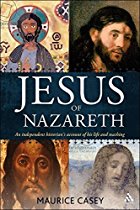 The stated purpose of Maurice Casey’s book Jesus of Nazareth is “to engage with the historical Jesus from the perspective of an independent historian.” Casey explains what he means by his independence: “I do not belong to any religious group or anti-religious group. I try to . . . establish historically valid conclusions. I depend on the best work done by many other scholars, regardless of their ideological affiliation.” (p. 2)
The stated purpose of Maurice Casey’s book Jesus of Nazareth is “to engage with the historical Jesus from the perspective of an independent historian.” Casey explains what he means by his independence: “I do not belong to any religious group or anti-religious group. I try to . . . establish historically valid conclusions. I depend on the best work done by many other scholars, regardless of their ideological affiliation.” (p. 2)
For Casey, the only correct interpretation of Jesus is one which explains Jesus within a thoroughly Jewish matrix. This means he in fact begins with the assumption that there is an historical Jesus to place within that matrix. He would disagree with that and argue that his book proves the existence of such a figure. On page 43 he writes of “people who deny Jesus’ existence” that
the whole of this book is required to refute them.
This brings to mind the frequent claims of one of another independent scholar who once quite regularly left a similar comment on this blog, saying that a whole book would be required to refute mythicism. Unfortunately, when a scholar says that his book is a refutation of mythicism, one is likely to find that the arguments of mythicists are avoided rather than refuted. I will return to this point.
Casey’s assertion that only a thoroughly Jewish Jesus is a correct Jesus means that for him many publications about the historical Jesus have missed the mark:
The vast majority of scholars have belonged to the Christian faith, and their portrayals of Jesus have consequently not been Jewish enough. Most other writers on Jesus have been concerned to rebel against the Christian faith, rather than to recover the Jewish figure who was central to Christianity in its earliest period. (p. 3, my emphasis) Continue reading “Maurice Casey on the Christ Myth–Historical Jesus Divide”
